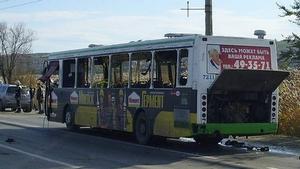Rail securityVolgograd train station bombing highlights need for more rail security
The recent train station bombing in Volgograd, Russia has focused attention on the vulnerabilities of rail infrastructure. According to a recently published report by IHS, purchases of explosives, weapons, and contraband (EWC) detection equipment at rail stations worldwide is expected to increase by 3.3 percent in 2014, and 8.8 percent in 2015.

Hulk of the burned-out bus attack in Volgograd, Russia // Source: zjol.com.cn
The recent train station bombing in Volgograd, Russia has once again focused attention on the vulnerabilities of rail infrastructure. According to a recently published report* by IHS, purchases of explosives, weapons, and contraband (EWC) detection equipment at rail stations worldwide is expected to increase by 3.3 percent in 2014, and 8.8 percent in 2015. A large amount of this growth is expected to come from Asia, where rail expansion projects are ongoing. As these rail project near completion, IHS expects to see an increase in purchases of explosives detection equipment.
Rail travel varies greatly by city, country, and region, leading to varying degrees of security. Unlike air travel, where all passengers and baggage is scanned for EWC, rail travel is not conducive to the same type of security measures. First, many passengers use rail services as their primary mode of transportation and depend on the easy access and convenience that rail transportation offers.
Second, many rail stations have higher passenger volumes than airports. For example, in 2013 Atlanta’s Hartsfield Jackson International Airport had 71.1 million passengers, whereas Tokyo’s Shinjuku Station had 1.26 billion passengers.
These factors have led to the development of new standoff detection technology to detect explosives in crowded areas. Ahead of the 2014 Winter Olympics, NATO and Russia started work on the Stand-Off Detection of Explosives (STANDEX) system. STANDEX was tested at several European rail stations and is expected to be deployed during the 2014 Winter Olympics. Worldwide rail stations continue utilize a combination of trace, advanced imagery, explosives detection canines, and explosives trace portals to detect explosives.
Overall, the use of explosives detection equipment remains limited at rail stations, but this is beginning to change as attacks on rail infrastructure continue. The development of new technologies that meet the unique security needs of the rail industry is expected to drive future growth in the market.
* The World Market for Explosives, Weapons, and Contraband (EWC) Detection Equipment— 2013 Edition is IHS Technology’s fifth edition study. Market data and forecast information are provided across five product types, nine end-user industries, and twenty-nine countries.
Jared Bickenbach is Market Analyst, Access Control, Fire & Security, IHS Technology
